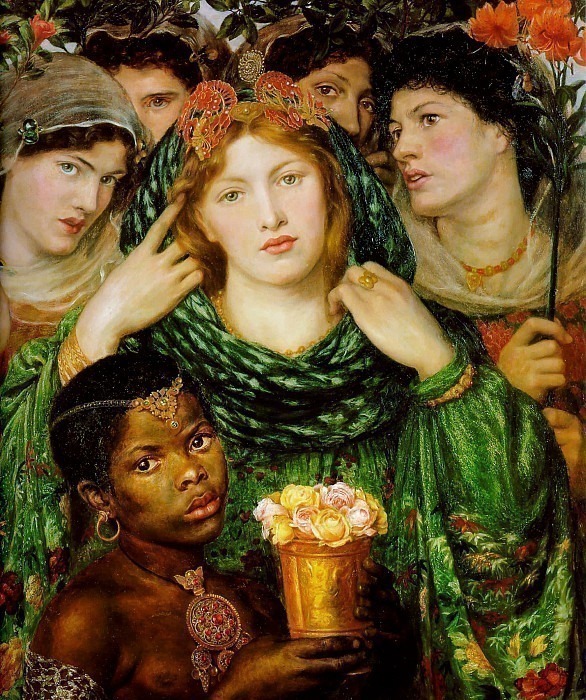The Beloved Dante Gabriel Rossetti (1828-1882)
Dante Gabriel Rossetti – The Beloved
Edit attribution
Download full size: 1778×2124 px (0,6 Mb)
Painter: Dante Gabriel Rossetti
"Beloved" (also known as "The Bride") is an oil on canvas painting painted in 1865 by the Italian-born British artist Dante Gabriel Rossetti. It is now in London’s Tate Gallery. The gilded frame bears two passages from the biblical canonical text known as the Song of Solomon. It is said that Rossetti, having completed the painting, nevertheless continually modified it throughout his life in search of perfection. The painting’s protagonist, caught in motion, lifts her veil, with four virgin girlfriends and an African servant boy arranged around her.
Description of Dante Rossetti’s Beloved (The Bride)
"Beloved" (also known as "The Bride") is an oil on canvas painting painted in 1865 by the Italian-born British artist Dante Gabriel Rossetti. It is now in London’s Tate Gallery. The gilded frame bears two passages from the biblical canonical text known as the Song of Solomon. It is said that Rossetti, having completed the painting, nevertheless continually modified it throughout his life in search of perfection.
The painting’s protagonist, caught in motion, lifts her veil, with four virgin girlfriends and an African servant boy arranged around her. Everything on the canvas contrasts with the reddish hue of the bride’s hair and pale skin: both the dark skin of the pageboy and the different shades of dark hair of the four girls and their skin tones. Many experts have suggested that Rossetti was influenced by Edouard Manet’s controversial painting Olympia, which emphasized all the features of the bride’s face, by this technique of color contrast. In 1865, while working on Beloved, Rossetti visited Manet’s exhibition and Olympia made an indelible impression on him. Many also find that the influence of Titian’s own works can be felt in Beloved.
Rossetti paid particular attention to the headdresses and garments of the bride and bridesmaids, in which an unimaginable combination of both Peruvian and Japanese national costume can clearly be discerned. Still, this profusion of exotic fabric only frames the face of the bride, a typically Western European type, who dominates the center of the canvas.
Кому понравилось
Пожалуйста, подождите
На эту операцию может потребоваться несколько секунд.
Информация появится в новом окне,
если открытие новых окон не запрещено в настройках вашего браузера.
You need to login
Для работы с коллекциями – пожалуйста, войдите в аккаунт (open in new window).



![Dante Gabriel Rossetti - A Persian Youth [Attributed]](http://cdn.gallerix.asia/j/R/178224391/5132.webp)
















You cannot comment Why?